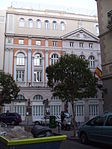Santa Bárbara, Madrid
18th-century Roman Catholic church buildings in SpainAC with 0 elementsBuildings and structures in Justicia neighborhood, MadridNeoclassical architecture in MadridRoman Catholic churches in Madrid

The Santa Barbara, also known as Church of the Monastery of the Salesas Reales is a Catholic church, built in Neoclassic style, in central Madrid, Spain. It is one of a number of Spanish churches dedicated to St Barbara.
Excerpt from the Wikipedia article Santa Bárbara, Madrid (License: CC BY-SA 3.0, Authors, Images).Santa Bárbara, Madrid
Calle del General Castaños, Madrid
Geographical coordinates (GPS) Address Phone number Nearby Places Show on map
Geographical coordinates (GPS)
| Latitude | Longitude |
|---|---|
| N 40.424527777778 ° | E -3.6938722222222 ° |
Address
Parroquia de Santa Bárbara (Iglesia de las Salesas Reales)
Calle del General Castaños 2
28004 Madrid (Centro)
Community of Madrid, Spain
Open on Google Maps









